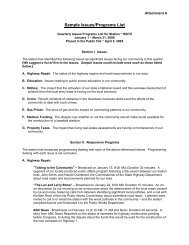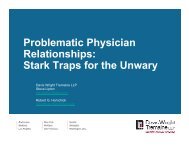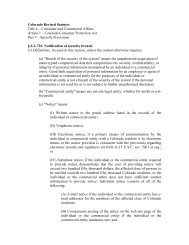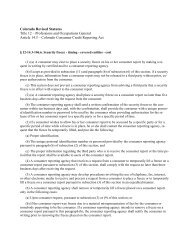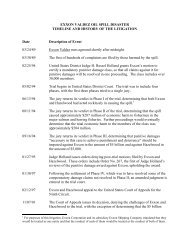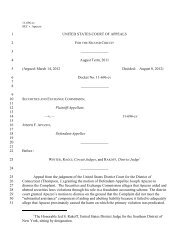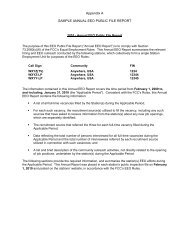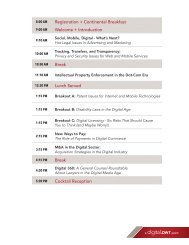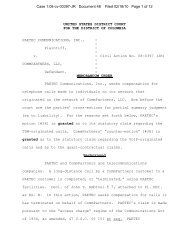QUANTA SERVICES INC, QUANTA SERVICES MANAGEMENT ...
QUANTA SERVICES INC, QUANTA SERVICES MANAGEMENT ...
QUANTA SERVICES INC, QUANTA SERVICES MANAGEMENT ...
Create successful ePaper yourself
Turn your PDF publications into a flip-book with our unique Google optimized e-Paper software.
<strong>QUANTA</strong> <strong>SERVICES</strong>, <strong>INC</strong>. AND SUBSIDIARIES<br />
NOTES TO CONSOLIDATED FINANCIAL STATEMENTS — (Continued)<br />
Compensation expense related to RSUs was $1.3 million and $0.5 million for the years ended<br />
December 31, 2011 and 2010. Such expense is recorded in selling, general and administrative expenses. As the<br />
RSUs are settled only in cash, they are not included in the calculation of earnings per share, and the estimated<br />
earned value of the RSUs is classified as a liability. Quanta paid $1.0 million and $0.3 million to settle liabilities<br />
related to RSUs in 2011 and 2010. Liabilities recorded under the RSUs were $1.3 million and $0.2 million at<br />
December 31, 2011 and 2010.<br />
Non-Cash Compensation Expense and Related Tax Benefits<br />
The amounts of non-cash compensation expense and related tax benefits, as well as the amount of actual tax<br />
benefits related to vested restricted stock and options exercised are as follows (in thousands):<br />
Year Ended December 31,<br />
2011 2010 2009<br />
Non-cash compensation expense related to restricted stock ............ $21,618 $22,125 $17,415<br />
Non-cash compensation expense related to stock options .............. — 923 2,460<br />
Total stock-based compensation included in selling, general and<br />
administrative expenses ...................................... $21,618 $23,048 $19,875<br />
Actual tax expense for the tax deductions from vested restricted stock . . . $ (1,160) $ (2,089) $ (1,567)<br />
Actual tax benefit (expense) for the tax deductions from options<br />
exercised ................................................. (205) (29) 354<br />
Actual tax expense related to stock-based compensation expense ....... (1,365) (2,118) (1,213)<br />
Income tax benefit related to non-cash compensation expense .......... 8,431 8,989 7,751<br />
Total tax benefit related to stock-based compensation expense ......... $ 7,066 $ 6,871 $ 6,538<br />
12. EMPLOYEE BENEFIT PLANS:<br />
Unions’ Multi-Employer Pension Plans<br />
Quanta contributes to a number of multi-employer defined benefit pension plans under the terms of<br />
collective bargaining agreements with various unions that represent certain of Quanta’s employees. Quanta’s<br />
contribution rates to the multi-employer pension plans generally are specified in the collective bargaining<br />
agreements (usually on an annual basis), and contributions are made to the plans on a “pay-as-you-go” basis<br />
based on its union employee payrolls. Quanta may also have additional liabilities imposed by law as a result of<br />
its participation in multi-employer defined benefit pension plans. The Employee Retirement Income Security Act<br />
of 1974, as amended by the Multi-Employer Pension Plan Amendments Act of 1980, imposes certain liabilities<br />
contingent upon an employer who is a contributor to a multi-employer pension plan if the employer withdraws<br />
from the plan or the plan is terminated or experiences a mass withdrawal. In the fourth quarter of 2011, Quanta<br />
recorded a partial withdrawal liability of approximately $32.6 million related to the withdrawal by certain Quanta<br />
subsidiaries from the Central States, Southeast and Southwest Areas Pension Plan (Central States Plan) following<br />
an amendment to the applicable collective bargaining agreement which eliminated their obligations to contribute<br />
to the Central States Plan. See further information regarding these subsidiaries’ withdrawal from the Central<br />
States Plan in Note 14—Collective Bargaining Agreements.<br />
The Pension Protection Act of 2006 (the PPA) also added special funding and operational rules generally<br />
applicable to plan years beginning after 2007 for multi-employer plans that are classified as “endangered,”<br />
“seriously endangered” or “critical” status based on a multitude of factors (including, for example, the plan’s<br />
111




